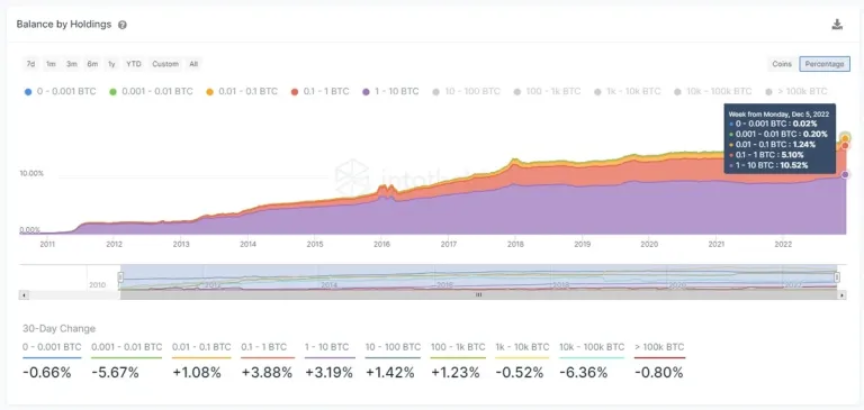21 Dec 2022 Samantha McLauren
17% Of The Total Circulating Bitcoin Is In The Hands Of Retail Investors
As the crypto 2022 is coming to an end, data from crypto analytics company Glassnode reveals that retail investors are now holding 17% of the total circulating BTC supply. According to the company, retail investors are considered those users who hold less than 10 Bitcoins (BTC), worth close to $169,000 per wallet address.
Glassnode’s data was confirmed by IntoTheBlock, which also shows that addresses with 0–10 BTC represent 17.3% of the entire supply of Bitcoin.
 Source: IntoTheBlock
Source: IntoTheBlock
Both Glassnode and IntoTheBlock stress that the rate of retail accumulation is on a steady increase, with 2020 marking a 12% rate, which coincides with the last phases of a late bull market/early bear market period for Bitcoin. In 2021, the world’s leading crypto showed a 13.9% retail accumulation. The last two significant retail accumulations happened in late 2013 and early 2014, and the final stages of the first massive bull run for Bitcoin were in December 2017.
However, Glassnode’s data includes groups of blockchain addresses that may or may not share the same owner as unique owners of Bitcoin, calling them “entities”.
Is Bitcoin centralized?
The data from Glassnode, however, don’t show the degree of ownership concentration, as the biggest crypto to date received many allegations for being centralized to a high extent. Indeed, some reports stated that only 2% of accounts owned 95% of all Bitcoin as of November 2020.
Glassnode responded to such allegations by noting that the company does not take into consideration the distinction between people and wallet addresses, as large-scale wallet addresses may be used by exchanges to manage and store Bitcoin on behalf of thousands or even millions of different users. Furthermore, the analytics company revealed that other cryptos such as Ethereum and Dogecoin are not that evenly distributed among different percentiles.
Ethereum, on the other hand, also received its fair share of centralization concerns, especially after the much-anticipated Merge event. It turns out that after Ethereum’s move to PoS, the community has voiced concerns about the blockchain’s centralization due to the high amount of ETH needed to become a validator. Despite Ethereum proponents are stating that anyone holding at least 32 ETH can become a network validator, many users stressed that 32 ETH may be a high barrier to overcome by ordinary retail traders and holders.
Indeed, after the Merge, only two ETH account held as much as 46.15% of the nodes that were used for data storage, transaction processing, and creating new blockchain blocks.
Bitcoin Ethereum Blockchain btc eth wallet dogecoin investing bitcoin news cryptocurrency news crypto news Exchanges Retail





























